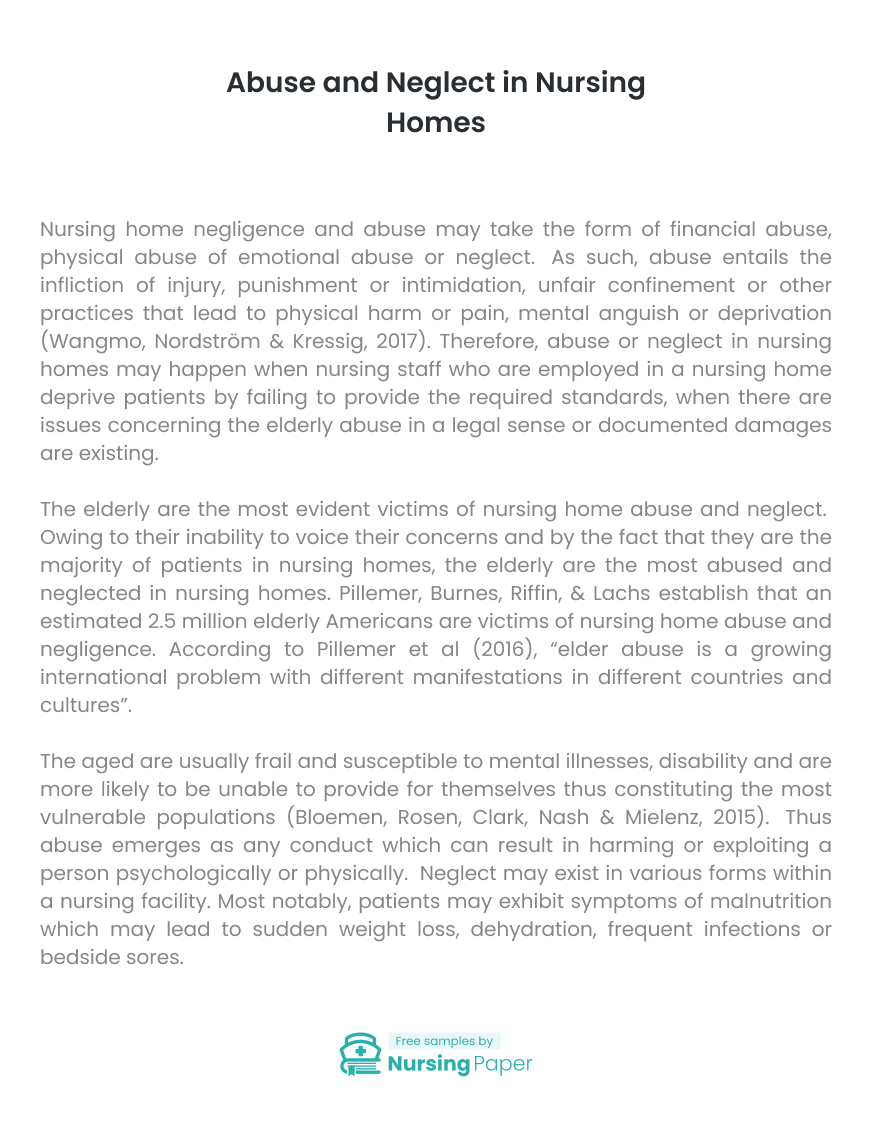
Abuse and Neglect in Nursing Homes
The Body
Nursing home negligence and abuse may take the form of financial abuse, physical abuse of emotional abuse or neglect. As such, abuse entails the infliction of injury, punishment or intimidation, unfair confinement or other practices that lead to physical harm or pain, mental anguish or deprivation (Wangmo, Nordström & Kressig, 2017). Therefore, abuse or neglect in nursing homes may happen when nursing staff who are employed in a nursing home deprive patients by failing to provide the required standards, when there are issues concerning the elderly abuse in a legal sense or documented damages are existing.
The elderly are the most evident victims of nursing home abuse and neglect. Owing to their inability to voice their concerns and by the fact that they are the majority of patients in nursing homes, the elderly are the most abused and neglected in nursing homes. Pillemer, Burnes, Riffin, & Lachs establish that an estimated 2.5 million elderly Americans are victims of nursing home abuse and negligence. According to Pillemer et al (2016), “elder abuse is a growing international problem with different manifestations in different countries and cultures”.


The aged are usually frail and susceptible to mental illnesses, disability and are more likely to be unable to provide for themselves thus constituting the most vulnerable populations (Bloemen, Rosen, Clark, Nash & Mielenz, 2015). Thus abuse emerges as any conduct which can result in harming or exploiting a person psychologically or physically. Neglect may exist in various forms within a nursing facility. Most notably, patients may exhibit symptoms of malnutrition which may lead to sudden weight loss, dehydration, frequent infections or bedside sores. Additionally, patients of neglect may exhibit withdrawal behavior which may present itself in the form of abnormal changes in a patient’s behavior, inability to create and sustain friendly relations with nursing home’s staff or changes in an appearance or hygiene. In as much as these direct symptoms indicate neglect¸ Bloemen et al., (2015) indicates that “a nursing home may fail to eliminate environmental hazards such as an unsafe wheelchair, poor lighting, slippery floors or unsafe furniture within the patient’s facility”.
Reports of high abuse and neglect among the elderly indicate that the state of nursing homes is a public concern. This is in accordance with a 2009 study by Gare-Olmo which indicated that more than a third of nursing homes in the United States reported to elderly abuse with majority of respondents being psychologically abused (Pillemer et al., 2016). On the contrary, the reporting of abuse and neglect by the elderly in nursing homes has been minimal though. Largely, this has been attributed to a lack of awareness or existence of different perceptions among the patients.
Examining the understanding of the phrase, “elderly abuse” among healthcare professionals and social workers, Gare-Olmo notes that healthcare professionals were largely unconversant, while the social workers emerged highly conversant (Pillemer et al., 2016). The researcher thus concluded that, “healthcare professionals have little training in chronological age structure”, an attribute he found essential for understanding the elderly care. Indeed, in his similar study on the rate of abuse in a nursing home among the elderly, he noted that elderly women above the age of 75 years were the biggest victims of interpersonal abuse and that men reported to loneliness in old age. Affirming the abuse and neglect among the elderly, the researcher noted that separated and divorced women were greatest victims of interpersonal abuse.

Certainly, abuse and neglect in nursing homes are more evident among the elderly. While this age bracket emerges as the most vulnerable, nursing homes may fail to protect environmental hazards to patients thus presenting challenges to patients of all ages. Therefore, it emerges that the failure of the aged to protect their rights is a great contribution towards abuse and neglect in nursing homes.
1. Bloemen, E. M., Rosen, T., Clark, S., Nash, D., & Mielenz, T. J. (2015). Trends in reporting of abuse and neglect to long term care ombudsmen: data from the National Ombudsman Reporting System from 2006 to 2013. Geriatric Nursing, 36(4), 281-283.
2. Pillemer, K., Burnes, D., Riffin, C., & Lachs, M. S. (2016). Elder abuse: global situation, risk factors, and prevention strategies. The Gerontologist, 56(Suppl_2), S194-S205.
3. Wangmo, T., Nordström, K., & Kressig, R. W. (2017). Preventing elder abuse and neglect in geriatric institutions: Solutions from nursing care providers. Geriatric Nursing, 38(5), 385-392.



The download will start shortly.

The download will start shortly.
 Subject:
Health and Social Care
Subject:
Health and Social Care  Number of pages: 2
Number of pages: 2  Subject:
Health and Social Care
Subject:
Health and Social Care  Number of pages: 7
Number of pages: 7  Subject:
Nursing
Subject:
Nursing  Number of pages: 5
Number of pages: 5  Subject:
Health and Social Care
Subject:
Health and Social Care  Number of pages: 2
Number of pages: 2  Subject:
Health and Social Care
Subject:
Health and Social Care  Number of pages: 4
Number of pages: 4  Subject:
Health and Social Care
Subject:
Health and Social Care  Number of pages: 7
Number of pages: 7  Subject:
Medicine
Subject:
Medicine  Number of pages: 2
Number of pages: 2  Subject:
Nursing
Subject:
Nursing  Number of pages: 3
Number of pages: 3  Subject:
Nursing
Subject:
Nursing  Number of pages: 3
Number of pages: 3  Subject:
Nursing
Subject:
Nursing  Number of pages: 13
Number of pages: 13  Subject:
Nursing
Subject:
Nursing  Number of pages: 2
Number of pages: 2  Subject:
Medicine
Subject:
Medicine  Number of pages: 9
Number of pages: 9  Subject:
Medicine
Subject:
Medicine  Number of pages: 8
Number of pages: 8  Subject:
Health and Social Care
Subject:
Health and Social Care  Number of pages: 2
Number of pages: 2  Subject:
Nursing
Subject:
Nursing  Number of pages: 5
Number of pages: 5 
